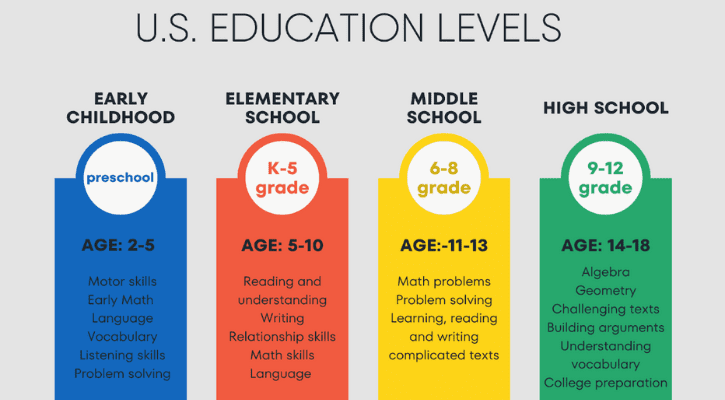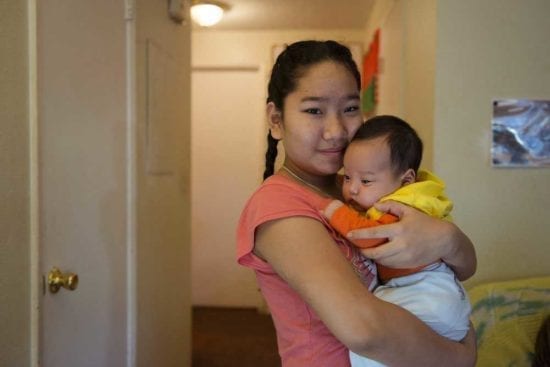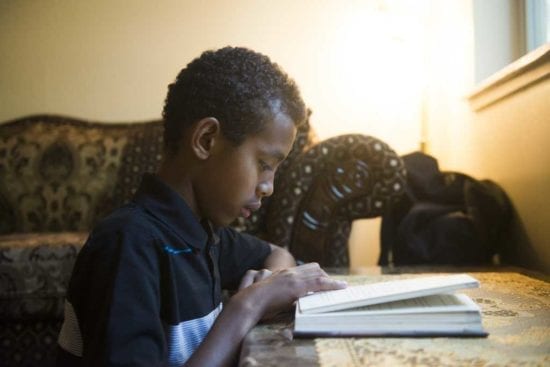What are the U.S. education levels?
There are different levels of public education in the U.S. Find information about pre-school, elementary school, middle school, and high school. Learn how schools decide the grade and type of class for students new to the USA.

Education in the USA
In the United States, the law requires all children to go to school. Elementary, middle, and high school are all free if your child attends public school . The ages of the students for each grade can vary from state to state.
U.S. education levels
In the USA, there are 12 grade levels after the first year of kindergarten. The four levels of education are:
- Preschool (early childhood education)
Elementary school
- Middle school
High school

Early childhood education
Early childhood education can mean different things. It refers to learning that happens before kindergarten. It is not required by law.
Early childhood education includes daycare and preschool . Ages can vary based on the place you choose to take your child. Daycare can start a few months after a child is born. Preschool can start as early as age 2.
You usually have to pay for daycare and preschool. There are free preschool options for families with low income through the Head Start program .
Children in preschool learn how to be with other kids and get ready for kindergarten.
Children begin elementary school with kindergarten (grade K) around age 5. The next year is grade 1 and it goes up each year to grade 5. They finish elementary school around age 10.
Children in elementary school usually learn different subjects from one teacher in a single classroom. They learn to develop writing and math skills, reading, critical thinking, and problem-solving.
Middle school (also called junior high school)
Students attending middle school are around age 11 to 13. It starts with grade 6 and ends with grade 8. Middle school students usually switch from classroom to classroom. They may have different teachers in one school day.
In middle school, students learn:
- English (grammar, spelling, reading comprehension, and sentence structure)
- Mathematics (fractions, decimals, percents, solving equations)
- Sciences (earth science, basic biology, basic chemistry concepts)
- Social studies (civics, government, and basic economics)
In some communities, children will not switch schools to go to middle school. They will keep going to the same elementary school.
Students attending high school are around age 14 to 18. It starts with grade 9 and ends with grade 12. The classes are arranged by subjects. A student usually has different teachers throughout the day.
In high school, students learn:
- English (classic literature, essay writing, and critical analysis)
- Mathematics (algebra, geometry, calculus)
- Science (biology, chemistry, physics)
- Social studies (US history, world history, and civics)
Some students can take advanced classes and prepare for work or college. High schools also have clubs, sports, work-study arrangements, and other activities.
There are names for students in each grade:
- 9th grade: freshman
- 10th grade: sophomore
- 11th grade: junior
- 12th grade: senior
Secondary School
A secondary school is an alternative option to a high school. It covers grades 9th to 12th. It offers technical and vocational training, such as carpentry and automotive technology.
Post-high school education
After getting a high school diploma, students can go to college. Students need to find a college or university and learn the requirements. You will have to apply and pay tuition. If you need help paying for college or university, there are scholarships for immigrants and refugees .

Public colleges
Public colleges are also known as city colleges and state colleges. Cities and states fund public colleges.
They have low-cost tuition for students who live in the city or state where the college is located.
Private colleges
Private college requires paid tuition. It doesn’t depend on the government, it receives funding from donors. There are private colleges that could provide students with many financial aid programs. Private colleges tend to have a smaller number of students.
Community colleges
You can finish community college in 2 years and then transfer to a University. Many community colleges have affordable and low tuition. Students will earn a certificate or an associate degree.
Some vocational-technical colleges are 2-year colleges.
Universities
Offer many career options; after 4 years of studies, students get a Bachelor’s Degree.
Universities have different colleges. Some universities offer professional degrees (law, medicine). These types of degrees need licenses and extra training.
Students who want to continue their education can apply for a Master’s degree or a Doctorate.
Class placement
Students can be split up by their learning level in different classes. This is more common in middle school and high school when students attend classes by subject with different teachers. Some levels of classes are harder and some are easier.
Class placement can be decided based on:
- How well the student understands English or their test scores
- Parent/guardian recommendations
- Standardized test scores
- Willingness to complete challenging assignments
- Student interest or motivation
- Teacher or counselor recommendation
- Samples of student work
The names of the classes sometimes describe the level of difficulty. The names can be different depending on the school.
- Basic skills
- GTE (Gifted and talented education)
- Advanced Placement (AP)
- IB (International Baccalaureate)
Grade level placement for students new to the USA
Grade level placement means deciding which grade a student will start in when they move to the USA.
Students may take some tests before the start of the school year or at the very beginning of the school year. The tests might be written or with an adult reading the questions to the student. It can be different depending on the school.
Many refugee students may have missed school while they were in camp or fleeing their country. They may be at different grade levels than a typical American student of the same age. Some students might be at a high-grade level but do not speak English yet. Those students may have trouble in harder classes until they learn English better.
If you think your child is in the wrong grade, you can talk to the teacher, principal, or the school staff who tested and placed your child.
- Ask, “What was your reasoning?” The school can help you understand their decision.
- Explain why you think the placement is wrong. They may be able to change the placement if they agree with your reasons.
We aim to offer easy to understand information that is updated regularly. This information is not legal advice.
More from USAHello
Looking for specific information?

Public school in the USA

Enroll my child in school

Childcare options

Education law and rights
Was this information helpful?
Illustration of a frowning, sad face Yes Illustration of a frowning, sad face No
What did you find helpful? (Choose all that apply)
How can we improve this information (choose all that apply), thank you very much.
We really appreciate you taking the time to give us your opinions about our website. If you are willing to send us your email address or phone number we would like to contact you to ask some follow up questions. Your name and information will not be shared with anyone, we will only use it to contact you to ask about our website.

IMAGES
VIDEO